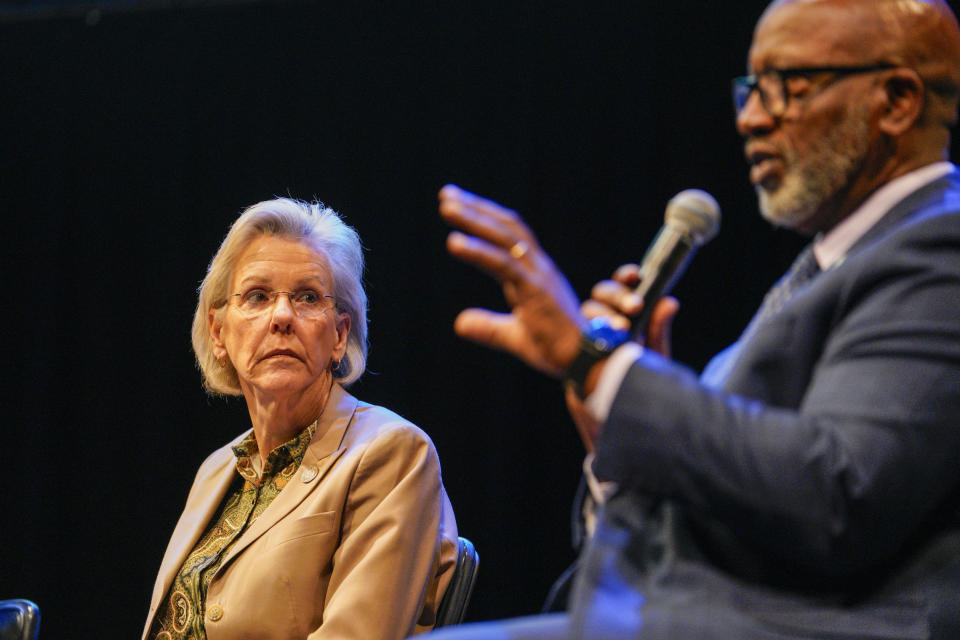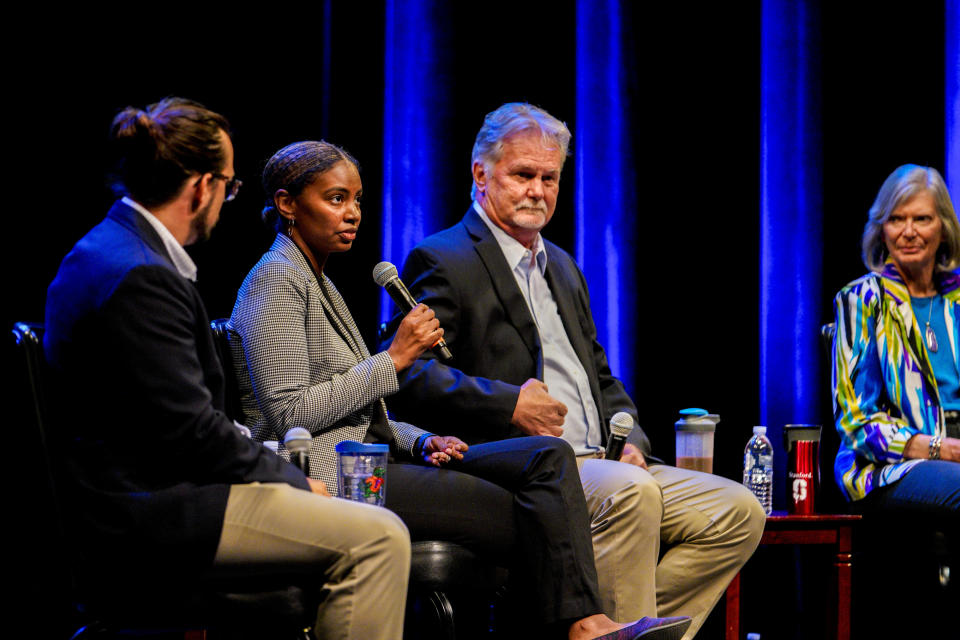2 takeaways from this week’s Spotlight Tampa Bay forum on climate change
- Oops!Something went wrong.Please try again later.
- Oops!Something went wrong.Please try again later.
Tampa Bay decision-makers and scientists met in downtown St. Petersburg earlier this week to discuss one of the most pressing issues of our time: the existential threat of climate change.
About 300 people attended the two-hour community conversation that explored environmental threats ranging from global to hyperlocal. The five-person panel honed in on how rising seas are flooding low-lying coastal communities, extinction rates are rising and stronger storms are washing away homes, streets and pipes — all amid a collapsing insurance market.
In a conversation led by Tampa Bay Times environment reporter Max Chesnes, panelists painted a picture of Tampa Bay’s future where rising seas will make some coastal areas unlivable.
But speakers also countered the doom and gloom — each of them told the audience they are hopeful for a future where science wins out and planet-warming emissions fall.
“There’s been a lot of positive things that have happened,” said Terry L. Root, a panelist and Nobel Prize-winning scientist. “It is not too late.”
Tuesday’s climate event, which was held at The Palladium and sponsored by Suncoast Credit Union, was the third event in the Times’ Spotlight Tampa Bay series, following previous forums on housing and education.
Along with Root, the panelists were Tampa Mayor Jane Castor; St. Petersburg Mayor Ken Welch; Cara Woods Serra, director of resiliency for the Tampa Bay Regional Planning Council; and Gary Mitchum, professor and associate dean in the College of Marine Science at the University of South Florida.
There were two top takeaways.
Retreat may be needed
Castor and Welch touched on a growing need to shift development and residents away from coastal, high-hazard areas — a challenging, long-term proposal given high real estate values along Florida’s waterfront.
In St. Pete, Welch said he’s spoken with city homeowners about raising homes and upgrading drainage systems. But conversations have recently shifted to buying out private property that is damaged repeatedly, storm after storm.
Post-disaster buyouts are common as a way to manage coastal retreat, which Welch alluded to during his time onstage.
The mayor said more than 40% of St. Petersburg sits in coastal, high-hazard areas where intense growth should be avoided.
“Frankly, there’s some places where we shouldn’t be developing. And at some point we’ve got to have that conversation,” Welch said. “In a city and county like St. Pete and Pinellas, we know how much revenue comes in from the beaches on the west coast. In 50 years, what will that look like?”
Castor said while her city has not yet considered buyouts, she expects parts of Tampa’s waterfront will be unlivable within the next 40 years. Long-term planning has been slow-going.
“Would I say that the people that live in my city are looking at 2075? Absolutely not,” Castor said.
When asked if Tampa’s current policy goes far enough to protect future development from sea-level rise, Castor replied “No, I don’t.”
Help needed with transportation, drainage
Tampa Bay’s greenhouse gas emissions were estimated for the first time this year by the Tampa Bay Regional Planning Council.
Transportation took the top spot as the largest emitting single sector, according to Serra, who directs the agency’s resiliency program. She took a moment to shout out the achievements of both mayors on this issue.
“They’re doing a lot to reduce greenhouse gas emissions,” Serra said. “Some of our cities and counties are more resource-constrained and clean energy is not their highest priority at this point.”
More than 40% of emissions are produced by transportation, mostly gas and diesel vehicles driving on the road, as well as the fuel burned by planes at Tampa International Airport, the report found. Energy — combining both residential and commercial use — in the Tampa Bay area accounts for roughly 45% of the region’s emissions.
“Now that we know those sectors, I think there’s more opportunities to start to tackle and address those,” Serra said.
Castor and Root said buses need greater use in Florida to cash in on the full benefits of public transportation.
“Mass transit is exactly the right issue that we need to talk about,” Root said. “To get Americans to ride mass transit, it’s going to take a paradigm shift.”
Root asked the audience to promise her their next vehicle is fully electric or hybrid.
“Make sure it plugs in,” she said to applause.
Welch praised St. Petersburg’s SunRunner bus rapid transit line, a fleet of hybrid electric vehicles that shuttles residents and visitors from downtown to the beaches. But he also acknowledged that Tampa Bay’s bus systems are “the most underfunded in the United States among major metros.”
When asked why, Welch quipped: “Well, it’s a long story, it’s much longer than two minutes. But they don’t have the funding and so, therefore, they don’t run late at night.”
The mayors also discussed current projects to refit backflow preventers in low-lying neighborhoods that often have their drainage systems overwhelmed during heavy rains and high tides.
“We’ve got to make those investments,” Welch said. “Our infrastructure hasn’t kept up with the changing threat.”


